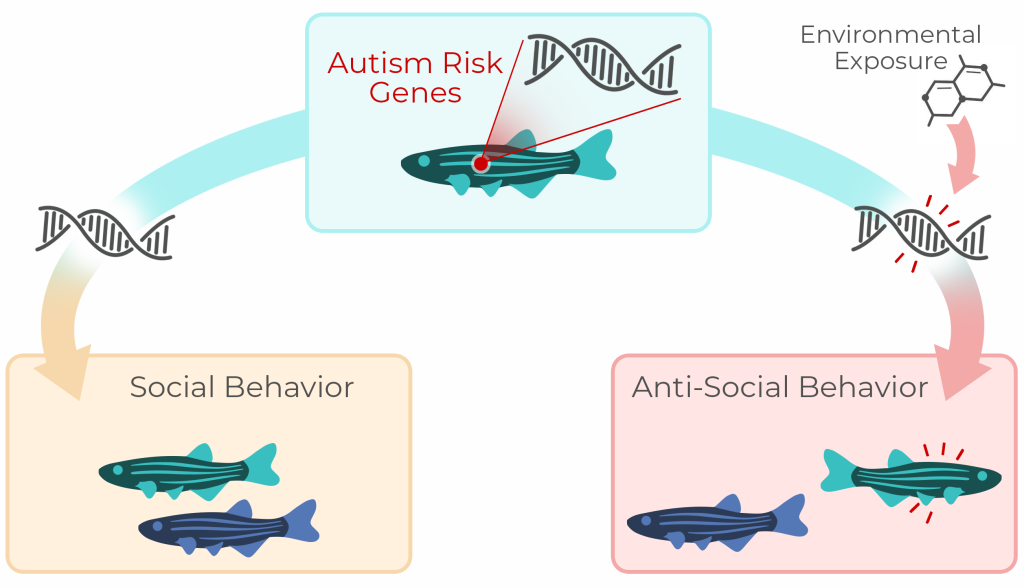The combined activities of an evolutionarily conserved enzyme and a regulatory protein control the expression of several genes that regulate the embryonic inception of sociability, claims an animal study published in the journal Science Advances on November 23, 2022. As part of this study, a team of scientists at the University of Utah screened 1,120 drugs and found that inhibiting the activity of Top2a (topoisomerase IIα) created lasting deficits in social behaviors in zebrafish, that normally develop a strong preference for fish their own age by three weeks of age.
“This study helps us understand at the molecular level why sociability is disrupted during the very earliest stages of life,” said Randall Peterson, PhD, the corresponding author of the study and dean of the University of Utah College of Pharmacy. “It also gives us an opportunity to explore potential treatments that could restore sociability in these animals and, perhaps in time, eventually in humans as well.”
The insights from mice and zebrafish studies suggest exposure to certain antibiotics called fluoroquinolones during embryonic development inhibits Top2a expression, leading to alterations in social behavior that are similar to those found in individuals with autism. The researchers also found inhibition of the Top2a-interacting regulatory protein (PRC2, polycomb repressive complex 2) rescued social deficits caused by exposure to the antibiotic. The study indicates, Top2a controls a large network of genes, known to increase the risk of autism. It also may serve as a link between genetic and environmental factors that contribute to the onset of social impairments, added Peterson.
Fishbook
To quantify social behavior in fish, the investigators created an automated assay system that they call Fishbook. Fishbook consists of a series of long rectangular lanes with solid walls. Each lane or “test arena” is divided into three parts by two transparent windows. The middle part is a long test compartment and each small compartment at the ends is either empty or holds a live fish as a social stimulus. To maximize throughput, the researchers grouped over 40 arenas together and hooked them up to a telecentric lens–based imaging system that simultaneously imaged all arenas.

Birth of sociability
Developmental biologists generally hold that social behaviors of adults take root before birth and is affected by genetic and environmental factors. But the molecular mechanisms have remained unclear.
In this study Peterson’s team exposed zebrafish embryos to 1120 drugs—one drug per 20 embryos—for 72 hours beginning at three days after conception. The Fishbook assay showed four of the 1,120 drugs reduced sociability in zebrafish. All four drugs were fluoroquinolone antibiotics that are used to treat respiratory tract infections in people.
The team then administered a related drug in pregnant mice, and found the offspring displayed reduced social interaction with other mice and repeatedly poked their heads in a hole. Social deficits and repetitive behaviors are two diagnostic features of autism.
Molecular analysis showed all four fluoroquinolones suppressed Top2a, which acts on several genes implicated in autism. The researchers also found that most of the autism-linked genes downstream of Top2A bind a group of proteins called PRC2. This led the researchers to hypothesize that Top2a and PRC2 work together to control the expression of the autism-linked genes.
The team then exposed embryonic and young zebrafish to an experimental drug that inhibits PRC2 (UNC1999), following exposure to fluoroquinolones. UNC1999 reduced social impairments in fluoroquinolone exposed fish. They saw similar results with other drugs that inhibit Top2a.
“That really surprised me because I would’ve thought disrupting brain development when you’re an embryo would be irreversible,” said Peterson. “If you don’t develop sociability as an embryo, you’ve missed the window. But this study suggests that even in those individuals later in life, you can still come in and inhibit this pathway and restore sociability.”



